Catherine of Aragon
Catherine of Aragon (Spanish: Catalina; 16 December 1485 – 7 January 1536) was Queen of England from June 1509 until May 1533 as the first wife of King Henry VIII; she was previously Princess of Wales as the wife of Henry's elder brother, Arthur.
| Catherine of Aragon | |
|---|---|
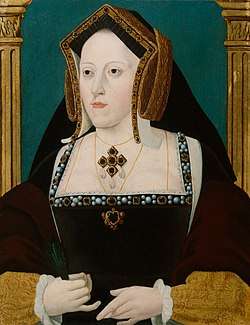 18th-century copy of a lost original portrait | |
| Queen consort of England | |
| Tenure | 11 June 1509 – 23 May 1533 |
| Coronation | 24 June 1509 |
| Born | 16 December 1485 Archiepiscopal Palace of Alcalá de Henares, Alcalá de Henares, Castile |
| Died | 7 January 1536 (aged 50) Kimbolton Castle, England |
| Burial | 29 January 1536 Peterborough Cathedral, Peterborough, England |
| Spouse | |
| Issue among others... | |
| House | Trastámara |
| Father | Ferdinand II of Aragon |
| Mother | Isabella I of Castile |
| Religion | Roman Catholicism |
| Signature | |
The daughter of Isabella I of Castile and Ferdinand II of Aragon, Catherine was three years old when she was betrothed to Arthur, Prince of Wales, heir apparent to the English throne. They married in 1501, but Arthur died five months later. She held the position of ambassador of the Aragonese Crown to England in 1507, the first female ambassador in European history.[1] Catherine subsequently married Arthur's younger brother, the recently ascended Henry VIII, in 1509. For six months in 1513, she served as regent of England while Henry VIII was in France. During that time the English crushingly defeated the Scottish at the Battle of Flodden, an event in which Catherine played an important part with an emotional speech about English courage.[2]
By 1525, Henry VIII was infatuated with Anne Boleyn and dissatisfied that his marriage to Catherine had produced no surviving sons, leaving their daughter, the future Mary I of England, as heir presumptive at a time when there was no established precedent for a woman on the throne. He sought to have their marriage annulled, setting in motion a chain of events that led to England's schism with the Catholic Church. When Pope Clement VII refused to annul the marriage, Henry defied him by assuming supremacy over religious matters. In 1533 their marriage was consequently declared invalid and Henry married Anne on the judgement of clergy in England, without reference to the Pope. Catherine refused to accept Henry as Supreme Head of the Church in England and considered herself the King's rightful wife and queen, attracting much popular sympathy.[3] Despite this, she was acknowledged only as Dowager Princess of Wales by Henry. After being banished from court by Henry, she lived out the remainder of her life at Kimbolton Castle, and died there on 7 January 1536 of cancer. The English people held Catherine in high esteem, and her death set off tremendous mourning.[4]
The Education of a Christian Woman by Juan Luis Vives, controversial at its release for promoting that women have the right to an education, was commissioned by and dedicated to her in 1523. Such was Catherine's impression on people that even her enemy, Thomas Cromwell, said of her, "If not for her sex, she could have defied all the heroes of History."[5] She successfully appealed for the lives of the rebels involved in the Evil May Day, for the sake of their families.[6] Catherine also won widespread admiration by starting an extensive programme for the relief of the poor.[7][6] She was a patron of Renaissance humanism, and a friend of the great scholars Erasmus of Rotterdam and Thomas More.[7]
Early life
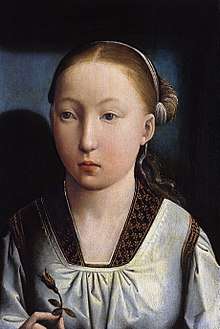
Catherine was born at the Archbishop's Palace of Alcalá de Henares near Madrid, on the night of 16 December 1485. She was the youngest surviving child of King Ferdinand II of Aragon and Queen Isabella I of Castile.[8] Catherine was quite short in stature[9] with long red hair, wide blue eyes, a round face, and a fair complexion.[10] She was descended, on her maternal side, from the House of Lancaster, an English royal house; her great-grandmother Catherine of Lancaster, after whom she was named, and her great-great-grandmother Philippa of Lancaster were both daughters of John of Gaunt and granddaughters of Edward III of England. Consequently, she was third cousin of her father-in-law, Henry VII of England,[11] and fourth cousin of her mother-in-law Elizabeth of York.
Catherine was educated by a tutor, Alessandro Geraldini, who was a clerk in Holy Orders. She studied arithmetic, canon and civil law, classical literature, genealogy and heraldry, history, philosophy, religion, and theology. She had a strong religious upbringing and developed her Roman Catholic faith that would play a major role in later life.[12] She learned to speak, read and write in Spanish and Latin, and spoke French and Greek. She was also taught domestic skills, such as cooking, dancing, drawing, embroidery, good manners, lace-making, music, needlepoint, sewing, spinning, and weaving.[13] Scholar Erasmus later said that Catherine "loved good literature which she had studied with success since childhood".[14]
At an early age, Catherine was considered a suitable wife for Arthur, Prince of Wales, heir apparent to the English throne, due to the English ancestry she inherited from her mother. By means of her mother, Catherine had a stronger legitimate claim to the English throne than King Henry VII himself through the first two wives of John of Gaunt, 1st Duke of Lancaster: Blanche of Lancaster and Constance of Castile. In contrast, Henry VII was the descendant of Gaunt's third marriage to Katherine Swynford, whose children were born out of wedlock and only legitimised after the death of Constance and the marriage of John to Katherine. The children of John and Katherine, while legitimised, were barred from inheriting the English throne, a stricture that was ignored in later generations. Because of Henry's descent through illegitimate children barred from succession to the English throne, the Tudor monarchy was not accepted by all European kingdoms. At the time, the House of Trastámara was the most prestigious in Europe,[11] due to the rule of the Catholic Monarchs, so the alliance of Catherine and Arthur validated the House of Tudor in the eyes of European royalty and strengthened the Tudor claim to the English throne via Catherine of Aragon's ancestry. It would have given a male heir an indisputable claim to the throne. The two were married by proxy on 19 May 1499 and corresponded in Latin until Arthur turned fifteen, when it was decided that they were old enough to be married.[15]
Catherine was accompanied to England by the ambassadors Diego Fernández de Córdoba y Mendoza, 3rd Count of Cabra, Alonso de Fonseca, archbishop of Santiago de Compostela, and Antonio de Rojas Manrique, bishop of Mallorca.[16] She brought a group of her African attendants with her, including one identified as the trumpeter John Blanke.[17] They are the first Africans recorded to have arrived in London at the time, and were considered luxury servants. They caused a great impression about the princess and the power of her family.[18] Her Spanish retinue was supervised by her duenna, Elvira Manuel.
As wife and widow of Arthur
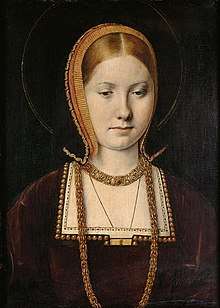
Then-15-year-old Catherine departed from A Coruña on 17 August 1501 and met Arthur on 4 November at Dogmersfield in Hampshire.[20][21][22] Little is known about their first impressions of each other, but Arthur did write to his parents-in-law that he would be "a true and loving husband" and told his parents that he was immensely happy to "behold the face of his lovely bride". The couple had corresponded in Latin, but found that they could not understand each other's spoken conversation, because they had learned different Latin pronunciations.[23] Ten days later, on 14 November 1501, they were married at Old St. Paul's Cathedral.[11] A dowry of 200,000 ducats had been agreed, and half was paid shortly after the marriage.[24]
Once married, Arthur was sent to Ludlow Castle on the borders of Wales to preside over the Council of Wales and the Marches, as was his duty as Prince of Wales, and his bride accompanied him. The couple stayed at Castle Lodge, Ludlow. A few months later, they both became ill, possibly with the sweating sickness, which was sweeping the area. Arthur died on 2 April 1502; 16-year-old Catherine recovered to find herself a widow.[25]
At this point, Henry VII faced the challenge of avoiding the obligation to return her 200,000 ducat dowry, half of which he had not yet received, to her father, as required by her marriage contract should she return home.[26] Following the death of Queen Elizabeth in February 1503, King Henry VII initially considered marrying Catherine himself, but the opposition of her father and potential questions over the legitimacy of the couple's issue ended the idea.[27] To settle the matter, it was agreed that Catherine would marry Henry VII's second son, Henry, Duke of York, who was five years younger than she was. The death of Catherine's mother, however, meant that her "value" in the marriage market decreased. Castile was a much larger kingdom than Aragon, and it was inherited by Catherine's elder sister, Joanna. Ostensibly, the marriage was delayed until Henry was old enough, but Ferdinand II procrastinated so much over payment of the remainder of Catherine's dowry that it became doubtful that the marriage would take place. She lived as a virtual prisoner at Durham House in London.[28] Some of the letters she wrote to her father complaining of her treatment have survived. In one of these letters she tells him that "I choose what I believe, and say nothing. For I am not as simple as I may seem." She had little money and struggled to cope, as she had to support her ladies-in-waiting as well as herself. In 1507 she served as the Spanish ambassador to England, the first female ambassador in European history.[1] While Henry VII and his councillors expected her to be easily manipulated, Catherine went on to prove them wrong.[1]
Marriage to Arthur's brother depended on the Pope granting a dispensation because canon law forbade a man to marry his brother's widow (Lev. 18:16[lower-alpha 1]). Catherine testified that her marriage to Arthur was never consummated as, also according to canon law, a marriage was not valid until consummated.[29][30]
Queenship
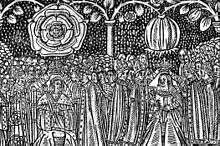
Wedding
Catherine's second wedding took place on 11 June 1509,[31] seven years after Prince Arthur's death. She married Henry VIII, who had only just acceded to the throne, in a private ceremony in the church of the Observant Friars outside Greenwich Palace. She was 23 years of age.[31][32]
Coronation
On Saturday 23 June 1509, the traditional eve-of-coronation procession to Westminster was greeted by a large and enthusiastic crowd. As was the custom, the couple spent the night before their coronation at the Tower of London. On Midsummer's Day, Sunday, 24 June 1509, Henry VIII and Catherine were anointed and crowned together by the Archbishop of Canterbury at a lavish ceremony at Westminster Abbey. The coronation was followed by a banquet in Westminster Hall. Many new Knights of the Bath were created in honour of the coronation.[31] In that month that followed, many social occasions presented the new Queen to the English public. She made a fine impression and was well received by the people of England.[25]
Pregnancies and children

Catherine was pregnant six times altogether:[33]
- In August 1509, two months after the wedding, Catherine's first pregnancy was announced. On 31 January 1510, she delivered a stillborn girl.
- In May 1510, four months after the loss of her first child, Catherine announced her second pregnancy. A son, Henry, Duke of Cornwall, was born on 1 January 1511. In his honour, guns were fired from the Tower of London and the city bells were rung, beacons were lit and free wine was distributed to all the population. Five days after his birth, on 6 January 1511, the prince was christened at Richmond Palace, his godparents being the Archbishop of Canterbury, the Earl of Surrey and the Countess of Devon. On 22 February 1511, after only 52 days of life, the young prince died suddenly. It was said that he died of an intestinal complaint.
- By early 1513, Catherine was pregnant again.[34] On 30 June 1513, Catherine was left as regent in England when Henry VIII went to fight in France. On 17 September 1513, she went into labour prematurely and gave birth to a boy who died shortly after birth.[35]
- In June 1514, Catherine announced her fourth pregnancy. In November 1514, she gave birth to a short lived boy.[36]
- In the summer of 1515, Catherine announced her fifth pregnancy; however, less hope was placed on an heir following her previous failed pregnancies. On 18 February 1516, Catherine delivered a healthy girl at 4 a.m. at Greenwich Palace, Kent.[37] She was named Mary and christened three days later (21 February) with great ceremony at the Church of Observant Friars. Despite his evident disappointment, Henry VIII said that if it were a girl this time then surely boys would follow.
- In July 1518, Catherine announced her sixth and final pregnancy,[38] and she visited Merton College, Oxford, and also made a pilgrimage to the shrine of St Frideswide, asking for a healthy son. On 10 November 1518 she gave birth to a daughter at 8 months gestation, but the child was weak and lived only a few hours.
Various other children are suggested by other authors and historians; J. J. Scarisbrick in his book, (Henry VIII, 1968) suggests that Catherine had "several miscarriages, three infants who were either stillborn or died immediately after birth (two of them males), two infants who died within weeks of birth (one of them a boy) and one girl, Princess Mary", which amounts to a total of nine pregnancies, since "several miscarriages" can hardly be regarded as referring to less than three; Hester W. Chapman in her book (Anne Boleyn, 1974) gives the total of pregnancies as seven, with "one live child and six that ended either in miscarriages or stillbirths."; Neville Williams in his book (Henry VIII and his court, 1971) is imprecise about the number of pregnancies but notes that, as early as 1511, Henry was "mindful of prior miscarriages". Referring to 1517, A. F. Pollard in his book (Henry VIII, 1925) suggests that "it is probable that about this time the Queen had various miscarriages". Various, like several, can hardly refer to less than three.
However, John Bowle (Henry VIII, 1964), rejects the 1517 miscarriages as "inventions" of Pollard and Sir John E. Neale agrees, describing the invention of the 1517 miscarriage as "mischievous". Both writers reject a son born in 1514, who was "no sooner christened than dead". Bowle, Chamberlain and Neale all agree as to six pregnancies for Catherine, ending with Mary in 1516, rejecting other pregnancies due to "insufficient evidence." Dewhurst rejects another miscarriage stated by Pollard in June 1514 as "impossible" due to Catherine being eight months pregnant in August.[39]
Influence
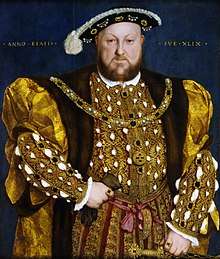
On 11 June 1513, Henry appointed Catherine Regent in England with the titles "Governor of the Realm and Captain General," while he went to France on a military campaign.[40] When Louis d'Orléans, Duke of Longueville, was captured at Thérouanne, Henry sent him to stay in Catherine's household. She wrote to Wolsey that she and her council would prefer the Duke to stay in the Tower of London as the Scots were "so busy as they now be" and she added her prayers for "God to sende us as good lukke against the Scotts, as the King hath ther."[41] The war with Scotland occupied her subjects, and she was "horrible busy with making standards, banners, and badges" at Richmond Palace. The Scots invaded and on 3 September 1513, she ordered Thomas Lovell to raise an army in the midland counties.[42]
Catherine rode north in full armour to address the troops, despite being heavily pregnant at the time. Her fine speech was reported to the historian Peter Martyr d'Anghiera in Valladolid within a fortnight.[43] Although an Italian newsletter said she was 100 miles (160 km) north of London when news of the victory at Battle of Flodden Field reached her, she was near Buckingham.[44] From Woburn Abbey she sent a letter to Henry along with a piece of the bloodied coat of King James IV of Scotland, who died in the battle, for Henry to use as a banner at the siege of Tournai.[45]
Catherine's religious dedication increased as she became older, as did her interest in academics. She continued to broaden her knowledge and provide training for her daughter, Mary. Education among women became fashionable, partly because of Catherine's influence, and she donated large sums of money to several colleges. Henry, however, still considered a male heir essential. The Tudor dynasty was new, and its legitimacy might still be tested.[46] A long civil war (1135–54) had been fought the last time a woman (Empress Matilda) had inherited the throne. The disasters of civil war were still fresh in living memory from the Wars of the Roses.[47]
In 1520, Catherine's nephew, the Holy Roman Emperor Charles V,[48] paid a state visit to England, and she urged Henry to enter an alliance with Charles rather than with France. Immediately after his departure, she accompanied Henry to France on the celebrated visit to Francis I, the Field of the Cloth of Gold. Within two years, war was declared against France and the Emperor was once again welcome in England, where plans were afoot to betroth him to Catherine's daughter Mary.
The King's great matter
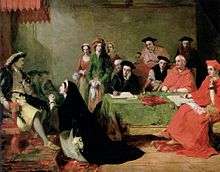
In 1525, Henry VIII became enamoured of Anne Boleyn, a lady-in-waiting to Queen Catherine; Anne was 11 years younger than Henry. Henry began pursuing her;[49] Catherine was no longer able to bear children by this time. Henry began to believe that his marriage was cursed and sought confirmation from the Bible, which he interpreted to say that if a man marries his brother's wife, the couple will be childless.[50][7] Even if her marriage to Arthur had not been consummated (and Catherine would insist to her dying day that she had come to Henry's bed a virgin), Henry's interpretation of that biblical passage meant that their marriage had been wrong in the eyes of God.[30] Whether the pope at the time of Henry and Catherine's marriage had the right to overrule Henry's claimed scriptural impediment would become a hot topic in Henry's campaign to wrest an annulment from the present pope.[30] It is possible that the idea of annulment had been suggested to Henry much earlier than this, and is highly probable that it was motivated by his desire for a son. Before Henry's father ascended the throne, England was beset by civil warfare over rival claims to the English crown, and Henry may have wanted to avoid a similar uncertainty over the succession.[51]
It soon became the one absorbing object of Henry's desires to secure an annulment.[52] Catherine was defiant when it was suggested that she quietly retire to a nunnery, saying: "God never called me to a nunnery. I am the King's true and legitimate wife."[53] He set his hopes upon an appeal to the Holy See, acting independently of Cardinal Thomas Wolsey, whom he told nothing of his plans. William Knight, the King's secretary, was sent to Pope Clement VII to sue for an annulment, on the grounds that the dispensing bull of Pope Julius II was obtained by false pretenses.
As the Pope was, at that time, the prisoner of Catherine's nephew Emperor Charles V following the Sack of Rome in May 1527, Knight had difficulty in obtaining access to him. In the end, Henry's envoy had to return without accomplishing much. Henry now had no choice but to put this great matter into the hands of Wolsey, who did all he could to secure a decision in Henry's favour.[54]
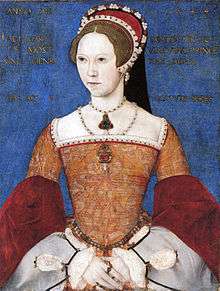
Wolsey went so far as to convene an ecclesiastical court in England with a representative of the Pope presiding, and Henry and Catherine herself in attendance. The Pope had no intention of allowing a decision to be reached in England, and his legate was recalled. (How far the pope was influenced by Charles V is difficult to say, but it is clear Henry saw that the Pope was unlikely to annul his marriage to the Emperor's aunt.[55]) The Pope forbade Henry to marry again before a decision was given in Rome. Wolsey had failed and was dismissed from public office in 1529. Wolsey then began a secret plot to have Anne Boleyn forced into exile and began communicating with the Pope to that end. When this was discovered, Henry ordered Wolsey's arrest and, had he not been terminally ill and died in 1530, he might have been executed for treason.[56] A year later, Catherine was banished from court, and her old rooms were given to Anne Boleyn. Catherine wrote in a letter to Charles V in 1531:
My tribulations are so great, my life so disturbed by the plans daily invented to further the King's wicked intention, the surprises which the King gives me, with certain persons of his council, are so mortal, and my treatment is what God knows, that it is enough to shorten ten lives, much more mine.[57][58]
When Archbishop of Canterbury William Warham died, the Boleyn family's chaplain, Thomas Cranmer, was appointed to the vacant position.[59]
When Henry decided to annul his marriage to Catherine, John Fisher became her most trusted counsellor and one of her chief supporters. He appeared in the legates' court on her behalf, where he shocked people with the directness of his language, and by declaring that, like John the Baptist, he was ready to die on behalf of the indissolubility of marriage. Henry was so enraged by this that he wrote a long Latin address to the legates in answer to Fisher's speech. Fisher's copy of this still exists, with his manuscript annotations in the margin which show how little he feared Henry's anger. The removal of the cause to Rome ended Fisher's role in the matter, but Henry never forgave him.[60][61] Other people who supported Catherine's case included Thomas More; Henry's own sister Mary Tudor, Queen of France (though as a member of the Tudor family and of royal blood, she was safe from any punishment and execution); María de Salinas; Holy Roman Emperor Charles V; Pope Paul III; and Protestant Reformers Martin Luther[62] and William Tyndale.[63]
Banishment and death
Upon returning to Dover from a meeting with King Francis I of France in Calais, Henry married Anne Boleyn in a secret ceremony.[64] Some sources speculate that Anne was already pregnant at the time (and Henry did not want to risk a son being born illegitimate) but others testify that Anne (who had seen her sister Mary Boleyn taken up as the king's mistress and summarily cast aside) refused to sleep with Henry until they were married. Henry defended the legality of their union by pointing out that Catherine had previously been married. If she and Arthur had consummated their marriage, Henry by canon law had the right to remarry.[65] On 23 May 1533, Cranmer, sitting in judgement at a special court convened at Dunstable Priory to rule on the validity of Henry's marriage to Catherine, declared the marriage illegal, even though Catherine testified she and Arthur had never had physical relations. Cranmer ruled Henry and Anne's marriage valid five days later, on 28 May 1533.[66]
Until the end of her life, Catherine would refer to herself as Henry's only lawful wedded wife and England's only rightful queen, and her servants continued to address her by that title. Henry refused her the right to any title but "Dowager Princess of Wales" in recognition of her position as his brother's widow.[64]
Catherine went to live at The More castle late in 1531.[67] After that she was successively moved to the Royal Palace of Hatfield, (May to September, 1532), Elsyng Palace, Enfield (September 1532 to February 1533), Ampthill Castle (February to July, 1533) and Buckden Towers (July 1533 to May 1534). She was then finally transferred to Kimbolton Castle where, she confined herself to one room (which she left only to attend Mass), dressed only in the hair shirt of the Order of St. Francis, and fasted continuously. While she was permitted to receive occasional visitors, she was forbidden to see her daughter Mary. They were also forbidden to communicate in writing, but sympathizers discreetly ferried letters between the two. Henry offered both mother and daughter better quarters and permission to see each other if they would acknowledge Anne Boleyn as the new queen. Both refused.[67]
In late December 1535, sensing her death was near, Catherine made her will, and wrote to her nephew, the Emperor Charles V, asking him to protect her daughter. It has been alleged that she then penned one final letter to Henry, her "most dear lord and husband":[68]
My most dear lord, king and husband,
The hour of my death now drawing on, the tender love I owe you forceth me, my case being such, to commend myself to you, and to put you in remembrance with a few words of the health and safeguard of your soul which you ought to prefer before all worldly matters, and before the care and pampering of your body, for the which you have cast me into many calamities and yourself into many troubles. For my part, I pardon you everything, and I wish to devoutly pray God that He will pardon you also. For the rest, I commend unto you our daughter Mary, beseeching you to be a good father unto her, as I have heretofore desired. I entreat you also, on behalf of my maids, to give them marriage portions, which is not much, they being but three. For all my other servants I solicit the wages due them, and a year more, lest they be unprovided for. Lastly, I make this vow, that mine eyes desire you above all things.
Katharine the Quene.
The authenticity of the letter itself has been questioned, but not Catherine's attitude in its wording, which has been reported with variations in different sources.[69]
Catherine died at Kimbolton Castle on 7 January 1536.[70] The following day, news of her death reached the king. At the time there were rumours that she was poisoned,[71][72][73] possibly by Gregory di Casale.[74] According to the chronicler Edward Hall, Anne Boleyn wore yellow for the mourning, which has been interpreted in various ways; Polydore Vergil interpreted this to mean that Anne did not mourn.[75] Chapuys reported that it was King Henry who decked himself in yellow, celebrating the news and making a great show of his and Anne's daughter, Elizabeth, to his courtiers.[76] This was seen as distasteful and vulgar by many. Another theory is that the dressing in yellow was out of respect for Catherine as yellow was said to be the Spanish colour of mourning. Certainly, later in the day it is reported that Henry and Anne both individually and privately wept for her death. On the day of Catherine's funeral, Anne Boleyn miscarried a boy. Rumours then circulated that Catherine had been poisoned by Anne or Henry, or both. The rumours were born after the apparent discovery during her embalming that there was a black growth on her heart that might have been caused by poisoning.[77] Modern medical experts are in agreement that her heart's discolouration was due not to poisoning, but to cancer, something which was not understood at the time.[78]
Catherine was buried in Peterborough Cathedral with the ceremony due to her position as a Dowager Princess of Wales, and not a queen. Henry did not attend the funeral and forbade Mary to attend.[78]
Faith
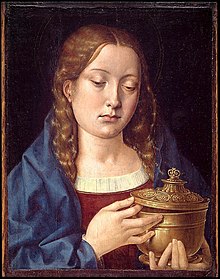
Catherine was a member of the Third Order of Saint Francis and she was punctilious in her religious obligations in the Order, integrating without demur her necessary duties as queen with her personal piety. After her divorce, she was quoted "I would rather be a poor beggar’s wife and be sure of heaven, than queen of all the world and stand in doubt thereof by reason of my own consent."[79]
The outward celebration of saints and holy relics formed no major part of her personal devotions,[80] which she rather expressed in the Mass, prayer, confession and penance. Privately, however, she was aware of what she identified as the shortcomings of the papacy and church officialdom.[80] Her doubts about Church improprieties certainly did not extend so far as to support the allegations of corruption made public by Martin Luther in Wittenberg in 1517, which were soon to have such far-reaching consequences in initiating the Protestant Reformation.
In 1523 Alfonso de Villa Sancta, a learned friar of the Observant (reform) branch of the Friars Minor and friend of the king's old advisor Erasmus, dedicated to the queen his book De Liberio Arbitrio adversus Melanchthonem denouncing Philip Melanchthon, a supporter of Luther. Acting as her confessor, he was able to nominate her for the title of "Defender of the Faith" for denying Luther's arguments.[81]
Appearance
Catherine was of a very fair complexion, had blue eyes, and had a hair colour that was between reddish-blonde and auburn. In her youth she was described as "the most beautiful creature in the world"[82] and that there was "nothing lacking in her that the most beautiful girl should have".[9] Thomas More and Lord Herbert would reflect later in her lifetime that in regard to her appearance "there were few women who could compete with the Queen [Catherine] in her prime."[83][84]
Legacy, memory, and historiography
.jpg)
The controversial book "The Education of Christian Women" by Juan Luis Vives, which claimed women have the right to an education, was dedicated to and commissioned by her. Such was Catherine's impression on people, that even her enemy, Thomas Cromwell, said of her "If not for her sex, she could have defied all the heroes of History."[5] She successfully appealed for the lives of the rebels involved in the Evil May Day for the sake of their families.[6] Furthermore, Catherine won widespread admiration by starting an extensive programme for the relief of the poor.[6] She was also a patron of Renaissance humanism, and a friend of the great scholars Erasmus of Rotterdam and Saint Thomas More. Some saw her as a martyr.[85][86]
In the reign of her daughter Mary I of England, her marriage to Henry VIII was declared "good and valid". Her daughter Queen Mary also had several portraits commissioned of Catherine, and it would not by any means be the last time she was painted. After her death, numerous portraits were painted of her, particularly of her speech at the Legatine Trial, a moment accurately rendered in Shakespeare's play about Henry VIII.
Her tomb in Peterborough Cathedral[87] can be seen and there is hardly ever a time when it is not decorated with flowers or pomegranates, her heraldic symbol. It bears the title Katharine Queen of England.
In the 20th century, George V's wife, Mary of Teck, had her grave upgraded and there are now banners there denoting Catherine as a Queen of England. Every year at Peterborough Cathedral there is a service in her memory. There are processions, prayers, and various events in the Cathedral including processions to Catherine's grave in which candles, pomegranates, flowers and other offerings are placed on her grave. On the service commemorating the 470th anniversary of her death, the Spanish Ambassador to the United Kingdom attended. During the 2010 service a rendition of Catherine of Aragon's speech before the Legatine court was read by Jane Lapotaire. There is a statue of her in her birthplace of Alcalá de Henares, as a young woman holding a book and a rose.[88]
Catherine has remained a popular biographical subject to the present day. The American historian Garrett Mattingly was the author of a popular biography Katherine of Aragon in 1942. In 1966, Catherine and her many supporters at court were the subjects of Catherine of Aragon and her Friends, a biography by John E. Paul. In 1967, Mary M. Luke wrote the first book of her Tudor trilogy, Catherine the Queen which portrayed her and the tumultuous era of English history through which she lived.
In recent years, the historian Alison Weir covered her life extensively in her biography The Six Wives of Henry VIII, first published in 1991. Antonia Fraser did the same in her own 1992 biography of the same title; as did the British historian David Starkey in his 2003 book Six Wives: The Queens of Henry VIII.[89][90][91] Giles Tremlett's biography Catherine of Aragon: The Spanish Queen of Henry VIII came out in 2010, and Julia Fox's 2011 dual biography Sister Queens: The Noble, Tragic Lives of Katherine of Aragon and Juana, Queen of Castile.
Places and statues
- In Alcalá de Henares, the place of Catherine's birth, a statue of Catherine as a young woman holding a rose and a book can be seen in the Archbishop's Palace.
- Peterborough is twinned with the Spanish city of Alcalá de Henares, located in the wider Community of Madrid. Children from schools in the two places have learned about each other as part of the twinning venture, and artists have even come over from Alcalá de Henares to paint Catherine's tombstone.
- Many places in Ampthill are named after Catherine. Also in Ampthill there is a cross in Ampthill Great Park named "Queen Catherine's Cross" in her honour. It is on the site of the castle where she was sent during her divorce from the King.
- Kimbolton School's science and mathematics block is called the QKB, or Queen Katherine Building.
Spelling of her name
Her baptismal name was "Catalina", but "Katherine" was soon the accepted form in England after her marriage to Arthur.[80] Catherine herself signed her name "Katherine", "Katherina", "Katharine" and sometimes "Katharina". In a letter to her, Arthur, her husband, addressed her as "Princess Katerine". Her daughter Queen Mary I called her "Quene Kateryn", in her will. Rarely were names, particularly first names, written in an exact manner during the sixteenth century and it is evident from Catherine's own letters that she endorsed different variations.[lower-alpha 2] Loveknots built into his various palaces by her husband, Henry VIII, display the initials "H & K",[lower-alpha 3] as do other items belonging to Henry and Catherine, including gold goblets, a gold salt cellar, basins of gold, and candlesticks. Her tomb in Peterborough Cathedral is marked "Katharine Queen of England".[92][93]
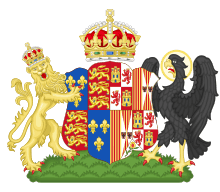
Ancestry
| Ancestors of Catherine of Aragon | ||||||||||||||||||||||||||||||||||||||||||||||||||||||||||||||||||||||||||||||||||||||||||||||||||||||||||||||||||||||||||||||||||||||||||||||||||||||||||||||||||||||||||||||||||||||||||||||||||||||||||||||||||||||||||||||||||||||||||||||||||||||||||||||||||||||||||||||||||||||||||||||||||||||||||||||||||||||||||||||||||||||||||||||||||||||||||||||||||||||||||||||||||||||||||||||||||||||||||||||||||||||||||||||||||||||||||||||||||||||||||||||||||||||||||||||||||||||||||||||||||||||||||||||||||||||||||||||||||||||||||||||||||||||||||||||||||||||||||||||||||||||||||||||||||||||||||||||||
|---|---|---|---|---|---|---|---|---|---|---|---|---|---|---|---|---|---|---|---|---|---|---|---|---|---|---|---|---|---|---|---|---|---|---|---|---|---|---|---|---|---|---|---|---|---|---|---|---|---|---|---|---|---|---|---|---|---|---|---|---|---|---|---|---|---|---|---|---|---|---|---|---|---|---|---|---|---|---|---|---|---|---|---|---|---|---|---|---|---|---|---|---|---|---|---|---|---|---|---|---|---|---|---|---|---|---|---|---|---|---|---|---|---|---|---|---|---|---|---|---|---|---|---|---|---|---|---|---|---|---|---|---|---|---|---|---|---|---|---|---|---|---|---|---|---|---|---|---|---|---|---|---|---|---|---|---|---|---|---|---|---|---|---|---|---|---|---|---|---|---|---|---|---|---|---|---|---|---|---|---|---|---|---|---|---|---|---|---|---|---|---|---|---|---|---|---|---|---|---|---|---|---|---|---|---|---|---|---|---|---|---|---|---|---|---|---|---|---|---|---|---|---|---|---|---|---|---|---|---|---|---|---|---|---|---|---|---|---|---|---|---|---|---|---|---|---|---|---|---|---|---|---|---|---|---|---|---|---|---|---|---|---|---|---|---|---|---|---|---|---|---|---|---|---|---|---|---|---|---|---|---|---|---|---|---|---|---|---|---|---|---|---|---|---|---|---|---|---|---|---|---|---|---|---|---|---|---|---|---|---|---|---|---|---|---|---|---|---|---|---|---|---|---|---|---|---|---|---|---|---|---|---|---|---|---|---|---|---|---|---|---|---|---|---|---|---|---|---|---|---|---|---|---|---|---|---|---|---|---|---|---|---|---|---|---|---|---|---|---|---|---|---|---|---|---|---|---|---|---|---|---|---|---|---|---|---|---|---|---|---|---|---|---|---|---|---|---|---|---|---|---|---|---|---|---|---|---|---|---|---|---|---|---|---|---|---|---|---|---|---|---|---|---|---|---|---|---|---|---|---|---|---|---|---|---|---|---|---|---|---|---|---|---|---|---|---|---|---|---|---|---|---|---|---|---|---|---|---|---|---|---|---|---|---|---|---|---|---|---|---|---|---|---|---|---|---|---|---|---|---|---|---|---|---|---|---|---|---|---|---|---|---|---|---|---|---|---|---|---|---|---|---|---|---|---|---|---|---|---|---|---|---|---|---|---|---|---|---|---|---|---|---|---|---|---|---|---|---|---|---|---|---|---|---|---|---|---|---|---|---|---|---|---|---|---|---|---|---|---|---|---|---|---|---|---|---|---|---|---|---|---|---|---|---|---|---|---|---|---|---|---|---|---|---|---|---|---|---|---|---|---|---|---|---|---|---|---|---|---|---|---|---|
| ||||||||||||||||||||||||||||||||||||||||||||||||||||||||||||||||||||||||||||||||||||||||||||||||||||||||||||||||||||||||||||||||||||||||||||||||||||||||||||||||||||||||||||||||||||||||||||||||||||||||||||||||||||||||||||||||||||||||||||||||||||||||||||||||||||||||||||||||||||||||||||||||||||||||||||||||||||||||||||||||||||||||||||||||||||||||||||||||||||||||||||||||||||||||||||||||||||||||||||||||||||||||||||||||||||||||||||||||||||||||||||||||||||||||||||||||||||||||||||||||||||||||||||||||||||||||||||||||||||||||||||||||||||||||||||||||||||||||||||||||||||||||||||||||||||||||||||||||
See also
- Cultural depictions of Catherine of Aragon
- Descendants of Isabella I of Castile and Ferdinand II of Aragon
- List of English consorts
Notes
- Canon law took this verse out of context, and Deuteronomy 25:5–10 required levirate marriage.
- Catherine's endorsement of different spellings can be identified in numerous letters, signing herself as 'Katharine the Quene' in a letter to Wolsey in 1513 and as 'Katharine' in her final letter to Henry VIII dating to Jan 1536.
- As Latin inscriptions were used in structures, a "C" represented the numeral 100, so a "K" was used instead. The same was applied during the time of Henri II and his wife Catherine during her state entry in Paris on 18 June 1549.
- Philippa of Lancaster was the daughter John of Gaunt, 1st Duke of Lancaster to his first wife Blanche of Lancaster,[104] making her half-sister of Catherine of Aragon's maternal great-grandmother Catherine of Lancaster, daughter of John of Gaunt, 1st Duke of Lancaster to his second wife Constance of Castile.
References
Citations
- Weir 1991, p. 59.
- Catherine of Aragon, Queen of England.
- Catherine of Aragon (1485–1536).
- Lehman 2011, p. 295.
- Chapuys 1533, p. 737.
- Deutscher & Bietenholz 1987, p. 283.
- Catherine of Aragon Biography.
- Lehman 2011, p. 283.
- Fraser 1992, p. 24.
- Weir 1991, p. 15.
- Lehman 2011, p. 284.
- Fraser 1992, p. 12.
- Weir 1991, p. 20.
- Dowling 1986, p. 17.
- Sanders & Low 1910, p. 235.
- Molina Recio, Raúl (2018), Diego Fernández de Córdoba y Mendoza (in Spanish), Real Academia de la Historia, retrieved 11 August 2019
- John Blanke.
- Goodwin 2008, p. 166.
- "Mary Rose Tudor". www.khm.at. Retrieved 9 July 2017.
- Starkey 2003, pp. 45–46.
- Tremlett 2010, p. 73.
- Cahill Marrón 2012.
- Fraser 1992, p. 25.
- "Catherine of Aragon Timeline". Historyonthenet.com. 15 October 2010. Retrieved 16 September 2013.
- Lehman 2011, p. 285.
- Maria Elizabeth Budden (1841). True Stories from English History. Chronologically Arranged from the Invasion of the Romans to the Present Time. By a Mother, Author of "True Stories from Ancient History", "Modern History", Etc. 5th Ed ... John Harris. p. 202.
- J. Madison Davis (2012). The Shakespeare Name and Place Dictionary. Routledge. p. 266. ISBN 978-1-136-64035-3.
- Williams 1971, p. 15.
- Weir 1991, p. 34.
- Lehman 2011, p. 290.
- Lehman 2011, p. 287.
- Eagles 2002, p. 194.
- Dewhurst, J. (1984). "The alleged miscarriages of Catherine of Aragon and Anne Boleyn". Medical History. 28 (1). p. 52–53. doi:10.1017/s0025727300035316. PMC 1139382. PMID 6387336.
- Rymer 1741, p. 48.
- According to Calendar of state papers and manuscripts relating to English affairs existing in the archives and collections of Venice (CSP Venice), edited by Rawdon Brown, vol. II, item 329, p. 140, the Spanish Ambassador - at the time Ambassador Mendoza - wrote that "a male heir was born to the King of England and will inherit the Crown, the other son having died.", which suggests the child was born alive.
- According to Dewhurst, the Venetian ambassador wrote to his senate in November that “The Queen has been delivered of a stillborn male child of eight months to the very great grief of the whole court”, Holinshed, the chronicler, ” reported that “in November the Queen was delivered of a prince which lived not long after”, and John Stow wrote “in the meantime, to Whit, the month of November, the Q was delivered of a prince which lived not long after”.
- Eagles 2002, p. 195.
- The alleged miscarriages of Catherine of Aragon and Anne Boleyn: Page 52 and 53 by Sir John Dewhurst: Her sixth and last confinement was announced by Henry in a personal letter to Cardinal Wolsey on 1 July 1518: "Two things there be which so secret that they cause me at this time to write to you myself; the one is that I trust the Queen my wife to be with child."
- Dewhurst, J. (1984). "The alleged miscarriages of Catherine of Aragon and Anne Boleyn". Medical History. 28 (1). p. 52–53. doi:10.1017/s0025727300035316. PMC 1139382. PMID 6387336.
- Rymer, Thomas, ed., Foedera, vol. 13 (1712), p. 370, Catherine was appointed "Rectrix" and "Gubernatrix" of England.
- Ellis 1846, p. 152–154.
- Rymer 1741, p. 49.
- Letters & Papers vol. 1 (1920), no. 2299: Catherine was issued with banners at Richmond on 8 September, Letters & Papers, vol.1 (1920), no.2243.
- Letters & Papers Henry VIII vol. 1 (1920) no. 2278: Calendar State Papers Venice, vol.2, no. 340: Hall, Edward, Chronicle, (1809), 564.
- Ellis 1846, p. 82–84, 88–89.
- Lehman 2011, p. 288–289.
- Wilkinson 2009, p. 70.
- Lehman 2011, p. 291.
- Scarisbrick 1997, p. 154.
- Leviticus 20:21.
- Lacey 1972, p. 70.
- Brigden 2000, p. 114.
- Farquhar 2001, p. 61.
- Herbermann, Charles, ed. (1913). . Catholic Encyclopedia. New York: Robert Appleton Company.
- Morris 1998, p. 166.
- Haigh 1993, p. 92.
- Norton, Elizabeth (2009). Jane Seymour: Henry VIII's True Love. Gloucestershire: Amberly Publishing. p. 32. ISBN 9781848681026.
- Gelardi, Julia P. (2009). In Triumph's Wake: Royal Mothers, Tragic Daughters, and the Price They Paid for Glory. New York: St. Martin's Press. ISBN 9781466823686.
- Herbermann, Charles, ed. (1913). . Catholic Encyclopedia. New York: Robert Appleton Company.
- Jestice 2004, p. 277.
- Rex 2003, p. 27.
- Brecht 1994, p. 44.
- Rees 2006, p. 77.
- Lehman 2011, p. 292.
- Starkey 2003, pp. 462–464.
- Williams 1971, p. 124.
- Lehman 2011, p. 293.
- Sharon Turner, The History of England from the Earliest Period to the Death of Elizabeth (Longman, Rees, Orme, Brown and Green,1828)
- Giles Tremlett 2010 in Catherine of Aragon, Henry VIII's Spanish Queen ISBN 978-0-571-23511-7 p. 422.
- Eagles 2002, p. 202.
- Letters and Papers of the Reign of Henry VIII, vol. X, no. 190.
- Letters and Papers of the Reign of Henry VIII, vol. X, no. 59.
- Letters and Papers of the Reign of Henry VIII, vol. X, no. 230.
- Letters and Papers of the Reign of Henry VIII, vol. X, no. 200.
- Warnicke 1991, p. 187.
- Warnicke 1991, p. 188.
- Lofts 1979, p. 139.
- Lehman 2011, p. 294.
- Bent, Samuel Arthur (1887). Familiar Short Sayings of Great Men (Sixth ed.). Boston: Ticknor & Co. Retrieved 25 November 2014.
- Davies, C. S. L.; Edwards, John (January 2008), "Katherine (1485–1536)", Oxford Dictionary of National Biography, Oxford, England: Oxford University Press, doi:10.1093/ref:odnb/4891
- Fraser 1992, p. 95.
- Weir 1991, p. 81.
- Weir 1991, p. 104.
- Strickland, p. 493.
- Letters and Papers of Henry VIII, vol. X, no. 212.
- Letters and Papers of Henry VIII, vol. X, no. 232.
- Froude 1891, p. 389.
- cubamagica (18 January 2009). "Catalina de Aragon on Flickr – Photo Sharing!". Flickr.com. Retrieved 16 September 2013.
- Starkey 2003, p. 1.
- Weir 1991, p. 1.
- Fraser 1992, p. 1.
- Fraser 1992, pp. 57–58.
- Elizabeth Jane Timms (6 March 2016). "Looking for a Queen of England in Peterborough". Royal Central. Retrieved 11 June 2019.
- Maclagan 1999, p. 27.
- Ferdinand I, King of Aragon at the Encyclopædia Britannica
- Edwards, John. The Spain of the Catholic Monarchs 1474–1520. Blackwell Publishers Inc, 2000, p. xiii
- López de Ayala (1779), Tome I, Crónica del rey don Pedro, Año Cuarto, Cap. XXVI, p. 111.
- López de Ayala (1780), Tome II, Crónica del rey Enrique II, Año Nono, Cap. II, p. 61.
- Ortega Gato, Esteban (1999). "Los Enríquez, Almirantes de Castilla" (PDF). Publicaciones de la Institución "Tello Téllez de Meneses". 70: 1–2. ISSN 0210-7317. Retrieved 17 May 2018.
- "Mariana de Ayala Córdoba y Toledo". Ducal House of Medinaceli Foundation. Retrieved 17 May 2018.
- John II, King of Castille at the Encyclopædia Britannica
- Leese, Thelma Anna, Blood royal: issue of the kings and queens of medieval England, 1066–1399, (Heritage Books Inc., 1996), 222.
- Lee, Sidney, ed. (1896). . Dictionary of National Biography. 45. London: Smith, Elder & Co. p. 167.
- Armitage-Smith, Sydney (1905). John of Gaunt: King of Castile and Leon, Duke of Aquitaine and Lancaster, Earl of Derby, Lincoln, and Leicester, Seneschal of England. Charles Scribner's Sons. p. 77. Retrieved 17 May 2018.
- Burkholder, Suzanne Hiles, "Isabella I of Castile" in Encyclopedia of Latin American History and Culture, vol.3, p. 298. New York: Charles Scribner's Sons 1996.
- Gerli, E. Michael; Armistead, Samuel G. (2003). Medieval Iberia. Taylor & Francis. p. 182. ISBN 9780415939188. Retrieved 17 May 2018.
Sources
Book sources
- Tremlett, Giles (2010). Catherine of Aragon: Henry's Spanish Queen. Faber and Faber. ISBN 978-0571235117.
- Weir, Alison (1991). The Six Wives of Henry VIII. Grove press. ISBN 0-8021-3683-4.
- Rymer, Thomas ed. Foedera, vol. 6 part 1, Hague (1741). letter to the treasurer John Heron.
- Cahill Marrón, Emma Luisa (2012). Arte y poder: negociaciones matrimoniales y festejos nupciales para el enlace entre Catalina Trastámara y Arturo Tudor (in Spanish). UCrea.
- Lehman, H. Eugene (2011). Lives of England's Reigning and Consort Queens. AuthorHouse Publishing. ISBN 978-1-4634-3057-3.
- Thomas B. Deutscher, Peter G. Bietenholz (1987). Contemporaries of Erasmus. University of Toronto Press. ISBN 978-0-8020-2575-3.
- Wilkinson, Josephine (2009). Mary Boleyn: the True Story of Henry VIII's Favourite Mistress. Amberley Publishing. ISBN 0-300-07158-2.
- Sigman, Mitchell (2011). Steal This Sound. Hal Leonard. ISBN 978-1-4234-9281-8.
- Goodwin, Stefan (2008). Africa in Europe: Antiquity into the Age of Global Exploration. Lexington Books. ISBN 978-0-7391-1726-2.
- Warnicke, Retha (1991). The Rise and Fall of Anne Boleyn. Cambridge University Press. ISBN 0-521-40677-3.
- Ellis, Henry, ed. (1846). Original Letters Illustrative of English History, 3rd Series, vol.1. Richard Bentley.CS1 maint: extra text: authors list (link)
- Frederick Sanders, Sir Sidney Low (1910). The dictionary of English history.
- Fraser, Antonia (1992). The Wives of Henry VIII. Vintage. ISBN 0-679-73001-X.
- Strickland, Agnes. Lives of the queens of England: from the Norman conquest, Volume 2.
- Lacey, Robert (1972). The Life and Times of Henry VIII. Book Club Associates.
- Chapuys, Eustace (Imperial Ambassador) (1533). Calendar of State Papers, Spanish IV.
- Froude, James Anthony (1891). The Divorce of Catherine of Aragon: The Story as Told by the Imperial Ambassadors Resident at the Court of Henry VIII. New York: Charles Scribner's Sons.
- Maclagan, Michael (1999). Line of Succession: Heraldry of the Royal Families of Europe. Little, Brown & Co.
- Haigh, Christopher (1993). English Reformations. Oxford University Press. ISBN 978-0-19-822162-3.
- Rees, Fran (2006). William Tyndale: Bible Translator And Martyr. Compass Point Books. ISBN 978-0-7565-1599-7.
- Dowling, Maria (1986). Humanism in the Age of Henry VIII. Other. ISBN 978-0-7099-0864-7.
- Scarisbrick, J. J (1997). Yale English Monarchs—Henry VIII. Yale University Press. ISBN 978-0-300-07158-0.
- Lofts, Norah (1979). Anne Boleyn. ISBN 0-698-11005-6.
- Brecht, Martin (1994). Martin Luther: shaping and defining the Reformation, 1521–1532. Fortress Press. ISBN 978-0-8006-2814-7.
- Brigden, Susan (2000). New Worlds, Lost Worlds The Rule of the Tudors, 1485–1603. Penguin (Non-Classics). ISBN 0-14-200125-2.
- Morris, T. A (1998). Europe and England in the Sixteenth Century. Routledge. ISBN 978-0-415-15041-5.
- Morton, Henry Vollam (1955). A stranger in Spain. Methuen. ISBN 978-0-413-52200-9.
- Eagles, Robin (2002). The Rough Guide History of England. Rough Guides. ISBN 978-1-85828-799-7.
- Rex, Richard (2003). The Theology of John Fisher. Cambridge University Press. ISBN 978-0-521-54115-2.
- Jestice, Phyllis G. (2004). Holy People of the World: A Cross-Cultural Encyclopedia, Volume 1. ABC-CLIO. ISBN 978-1-57607-355-1.
- Starkey, David (2003). Six Wives: The Queens of Henry VIII. ISBN 0-06-000550-5.
- Williams, Neville (1971). Henry VIII and His Court. Macmillan Pub Co. ISBN 978-0-02-629100-2.
- Bietenholz, P. G.; Deutscher, Thomas B. (2003). Contemporaries of Erasmus: A Biographical Register of the Renaissance and Reformation. University of Toronto Press.
- Farquhar, Michael (2001). A Treasury of Royal Scandals: The Shocking True Stories History's Wickedest, Weirdest, Most Wanton Kings, Queens, Tsars, Popes, and Emperors. Penguin. ISBN 978-0140280241.CS1 maint: ref=harv (link)
Internet sources
- "Historical research on Catherine of Aragon". Academia.edu. December 2016.
- "Historical research on Catherine and Arthur's marriage in 1501" (PDF). UCrea. September 2012.
- "Catherine of Aragon (1485–1536)". BBC. Retrieved 8 September 2012.
- "Catherine of Aragon Biography". Biography Channel. Archived from the original on 7 November 2012. Retrieved 8 September 2012.
- "John Blanke—A Trumpeter in the court of King Henry VIII". Blackpresence. 12 March 2009. Archived from the original on 26 March 2012. Retrieved 17 March 2011.
- "Catherine of Aragon, Queen of England". King's College, Pennsylvania. Retrieved 8 September 2012.
Bibliography
- John E. Paul (1966) Catherine of Aragon and Her Friends. Fordham University Press ISBN 978-0-8232-0685-8
- Mattingly, Gareth (2005) Catherine of Aragon. Ams Pr Inc. ISBN 978-0-404-20169-2
- J.O. Hand & M. Wolff, (1986) Early Netherlandish Painting, National Gallery of Art, Washington (catalogue) ISBN 0-521-34016-0
- Tremlett, Giles. (2010). Catherine of Aragon: The Spanish Queen of Henry VIII. Faber & Faber. ISBN 978-0-571-23512-4
- Cahill Marrón, Emma Luisa (2014). "Medieval or Modern Queen? Catherine of Aragon's role in the Anglo-Spanish alliance and her contribution to the introduction of New Learning in England".
- Williams, Patrick. (2012). Catherine of Aragon. Amberley. ISBN 978-1-84868-325-9
- Gardner, Laurien. (2008). The Spanish Bride: A Novel of Catherine of Aragon (Tudor Women Series).Berkley Trade. ISBN 0-425-21996-8
- Prince, Alison. (2010). Catherine of Aragon (My Royal Story). Scholastic; 1 edition. ISBN 978-1-4071-2071-3
- Luke, Mary M. (1967). Catherine, The Queen, a biography of Catherine of Aragon, first wife to Henry VIII. Coward-McCann, Inc.
- Lofts, Norah. (2008). The King's Pleasure: A Novel of Katharine of Aragon. Touchstone. ISBN 978-1-4165-9089-7
- Plaidy, Jean (1968). Katharine of Aragon. Robert Hale Ltd. ISBN 978-0-7091-0511-4.
- De rebus Britannicis collectanea, cum Thomae Hearnii praesatione notis et indice ad editionem primam. Ed. altera. White. 1774.
- Hardwicke, Philip Yorke of, ed. (1778). Miscellaneous State Papers: From 1501 to 1726. In Two Volumes. Strahan and Cadell., [[ Miscellaneous State Papers, vol.1 (1778)]] pp. 1–20, instructions for her wedding to Arthur.
- Lindsey, Karen. (1995). Divorced Beheaded Survived: A Feminist Reinterpretation of the Wives of Henry VIII. ISBN 0-201-40823-6
- Coates, Tim. (2001). Letters of Henry VIII 1526–29.Tim Coates Books. ISBN 978-0-11-702453-3
- Ashley, Mike. (2002). British Kings & Queens. ISBN 0-7867-1104-3
- Meyer, Carolyn (2009). Patience, Princess Catherine. Graphia. ISBN 978-0-15-205447-2.
- Bernard, G.W. (2007). The King's Reformation: Henry VIII and the Remaking of the English Church. ISBN 978-0-300-12271-8
- Strickland, Agnes (1860). Lives of the Queens of England, from the Norman Conquest: With Anecdotes of Their Courts. Brown & Taggard.
External links
| Wikisource has original text related to this article: |
- . Encyclopædia Britannica. 5 (11th ed.). 1911.
- Catherine of Aragon's divorce papers and other Tudor treasures online to mark the 500th anniversary of Henry VIII's accession
- tudorhistory.org – An overview of her life, accompanied by a portrait gallery
- englishhistory.net – An in-depth look at her life and times
- A geo-biography of the Six Wives of Henry the VIII on Google Earth
- Guardian unlimited, letter from her to Pope Clement VII
- Katharine of Aragon.com – An Official Website For Her Cause
- Project Continua: Biography of Catherine of Aragon
Catherine of Aragon Born: 16 December 1485 Died: 7 January 1536 | ||
| English royalty | ||
|---|---|---|
| Vacant Title last held by Elizabeth of York |
Queen consort of England Lady of Ireland 1509 – 1533 |
Vacant Title next held by Anne Boleyn |
| Diplomatic posts | ||
| Preceded by Rodrigo Gonzalez de Puebla |
Ambassador of Aragon to England 1507 – 1509 with Rodrigo Gonzalez de Puebla (1507–1508) Gutierre Gómez de Fuensalida (1508–1509) |
Succeeded by |